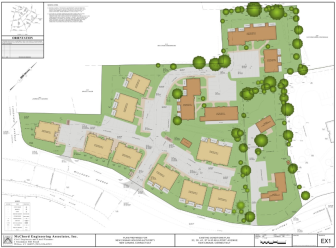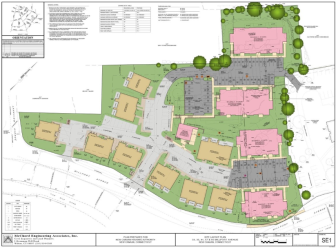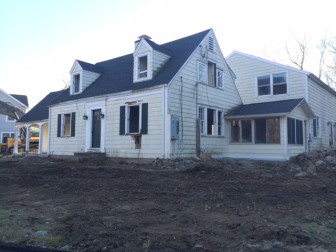The first phase of a large-scale plan to create more public housing at Mill Pond is underway and on track for completion by year’s end, officials say—a widely anticipated project that’s expected to trigger temporary relief for New Canaan from a state law that allows developers to skirt local planning decisions.

Existing site plan of affordable housing at Millport Avenue. Rendering courtesy of Jonathan Rose Companies, a Stamford-based firm that’s working in a construction manager capacity with the New Canaan Housing Authority on the Millport redevelopment.
Under the Affordable Housing Appeals Act, towns where less than 10 percent of the housing stock qualifies as “affordable” by the state’s definition (New Canaan’s is at about 2.4 percent), developers may bypass Planning & Zoning by designating a percentage of units within proposed new structures as affordable.
Ten percent is a rigorous standard that towns such as New Canaan are unlikely to meet, mostly because the state in calculating “affordable” lumps the town into the sprawling geography of the “Norwalk-Stamford Metropolitan area.”

Proposed site plan of affordable housing at Millport Avenue. Rendering courtesy of Jonathan Rose Companies
Yet there’s a way to get relief under a provision (a complicated provision) in the state law. Under the provision, types of housing are assigned a certain number of points based on variables such as how much they cost (in mortgage payments or rent) and whom they serve (seniors or families). If a town amasses enough “housing unit equivalent” points, it can earn a four-year exemption.
The first phase of a plan to trigger that exemption—by adding about 36 units to the Millport Apartments—“should be done some time right around the end of the year,” Housing Authority Commission Chairman Scott Hobbs told members of the Town Council during their Feb. 24 meeting.

This home on Millport Avenue is slated for demolition to make way for new affordable housing construction. MS photo
Referring to the state law’s Connecticut General Statute number, Hobbs added at the meeting, held at Town Hall: “That actually is going to give us the first moratorium under the 8-30g rules for the ‘zoning buster’ rules that will help to protect us.”
It’s an important standard for New Canaan to meet in order to avoid seeing unwanted projects shoehorned into available lots.
New Canaanites will recall that a developer had threatened to leverage the Affordable Housing Appeals Act in order to develop at Jelliff Mill. In that case, the town ended up approving the development in exchange for $200,000 paid into its fund for creating affordable units. Fears that the law would be invoked resurfaced when the Roger Sherman Inn hit the market for $6 million in August 2014 (later removed), and for many those fears remain.
Hobbs’ comments emerged as he sought approval from the Town Council to spend an additional $200,000 on phase one of the Millport Avenue project (phase two will see an additional 30 units created—the plans were filed in the fall of 2014). According to Hobbs, the money will be used to restore some amenities to the new structures that had been removed for cost reasons (such as balconies and washers-dryers, he said). The $200,000 itself is already in hand, in a special fund that the town maintains, composed of fees that that property owners and contractors pay whenever they file a residential building permit application.
“Luckily we have that fund, because otherwise we would be much more subject to the sort of blackmail that Darien and other communities are subject to,” Hobbs said.
The councilmen (as did the Boards of Finance and Selectmen before them) approved the allocation unanimously.
Town Council Vice Chairman Steve Karl asked whether there’s any end to New Canaan’s need to secure the moratorium every four years.
“Is there at some point do they [state officials] say ‘Great job New Canaan, it’s time you rest’?” Karl asked. “When will that be?”
Hobbs replied that New Canaan’s chances of achieving the 10 percent goal “are pretty slim.”
“That said, there are opportunities on Canaan Parish [at Lakeview Avenue and 123], there are opportunities any time another development comes up and also, quite frankly as time goes on, the possible sites that can be used diminish. Which is never to say that somebody can’t come up and say, ‘I’m going to put 45 units on an acre right in the middle of town in a 6-story building.’ But that is harder to do, so the longer we can if we can get an 8-year window and that gets us out to 2025, and there will be a new board here and I’m sure they will figure out how to do it.”
Councilmen Penny Young and Chairman Bill Walbert praised Hobbs and his fellow commissioners—Tim Welch, Mike Sweeney, Bernard Simpkin and Kara-Marie Laviola (a resident of Millport, read more on her here)—for their diligence. Hobbs in turn credited former P&Z Chairman and current commissioner Laszlo Papp for his foresight in identifying the potential problem of 8-30g for New Canaan, and former Housing Authority Commissioner Chuck Berman for developing the Millport Avenue rebuilding plan.
Hobbs said the project will earn New Canaan its first 4-year moratorium and go some way toward securing a second one.
Hopefully, he said, New Canaan can then secure a third one.
“Past that point that it is going to take some real vision and planning” to find relief from the state law, he said.
